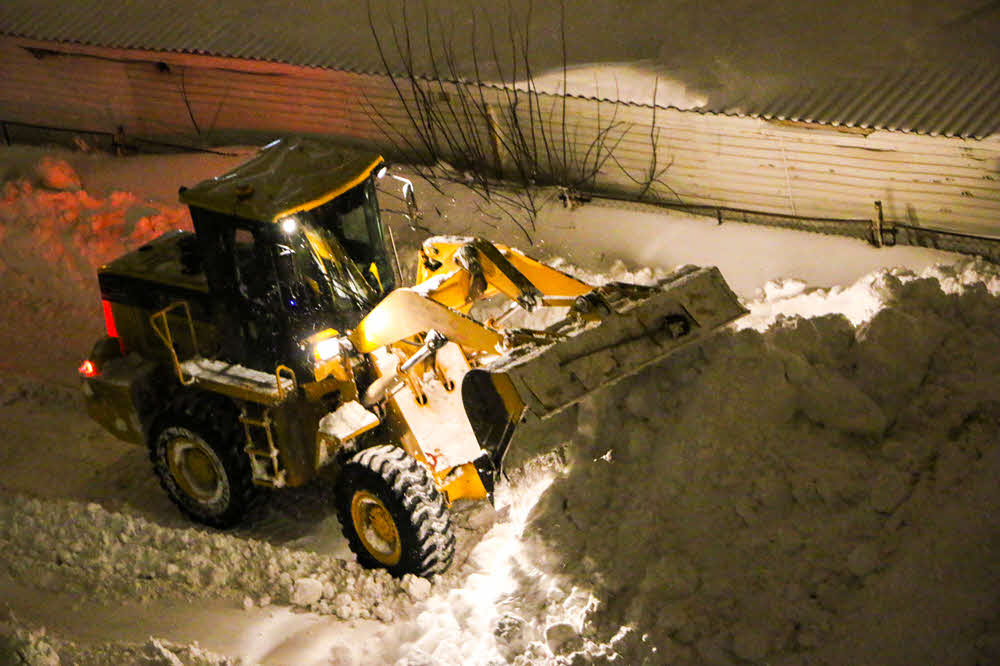Emergency Snow Plowingin Saint Clair Shores MI
Rapid Response Snow Plowingto Keep Your Business Running
We Are Locally Owned & Operated For Over 37 Years
Contact Us Today!
We Serve Businesses In And Around The Following Cities:
About Emergency Snow Plowing
Understanding the Urgency of Snow Plowing in Saint Clair Shores
As the winter months roll in and the temperature starts to drop, the charming city of Saint Clair Shores, nestled next to the breathtaking Lake Saint Clair, prepares itself for the annual snowfall. The beauty of shimmering white vistas often comes with the inconvenience of blocked paths and driveways, hindering business operations. Particularly for commercial properties, delayed or inefficient snow clearing can significantly impact daily operations. This underscores the absolute necessity of reliable, urgent commercial snow plowing services.
The Essence of Emergency Snow Plowing
Emergency snow plowing serves as the backbone of a city’s winter damage control, ensuring swift and efficient removal of snow from commercial properties. Unlike regular snow plowing, this service operates on demand, truly signifying its role as an ’emergency’ solution. The service is particularly beneficial for commercial spaces as it aids in maintaining the aesthetic appeal of the property, ensuring customer satisfaction, preventing accidents, and aiding in regular business operations. Imagine a customer struggling to get their car into your snow-filled parking lot; not an ideal scenario for either party. Emergency business driveway clearing can be a lifesaver in such scenarios.
For instance, in our city of Saint Clair Shores, a medical facility or a restaurant cannot afford a snow-blocked driveway. Both operational efficiency and public safety are at stake. As such, an essential and strategic partnership with a firm providing 24-hour commercial snow plowing services is vital, particularly during the peak winter months.
The Process Explained
A typical emergency snow plowing session begins with an inspection of the snow-covered area. Snow plowing professionals then strategize on the most effective way to clear the snow, factoring in elements like the property’s layout, snow volume, and forecasted weather patterns for optimal results. The equipment used for the process is specifically designed for heavy-duty snow clearance, guaranteeing effective snow removal without damaging the property. For more urgent snow plowing requests, powerful truck-mounted plows are often employed to handle high volumes of snow within a short span.
In the city of Saint Clair Shores, a firm such as D&J Contracting would, for example, promptly respond to an emergency driveway clearing call, dispatching a seasoned team equipped with advanced machinery for the task. Firms of this caliber offer efficient services round the clock, ensuring no business has to deal with the repercussions of a snow-covered driveway for too long.
Profiling the Benefits of Emergency Snow Plowing for Businesses
Proactive snow plow emergency services offer diverse benefits for commercial properties. First, it boosts visual appeal. Clear driveways and walkways make a commercial property look well-maintained and inviting. Second, it ensures safety. Immediate clearing of snow can considerably reduce slip-and-fall accidents, protecting both employees and customers. Lastly, such services significantly contribute to operational efficiency. No longer do businesses have to wait for city’s snowplows to clear the snow. Commercial services cater specifically to their needs, ensuring minimal downtime.
Just imagine your place of business the day after heavy snowfall; the city public services haven’t yet reached your location, and you face the challenges of a blocked entrance and parking area. Here’s where a 24-hour snow plowing service could step in to resolve your problems.
Real-World Applications of Emergency Snow Plowing
Take, as a concrete instance, a hospital in Saint Clair Shores. A medical facility’s operation cannot be delayed or disturbed; rapid access is a matter of life and death. Therefore, professional services offering emergency snow plowing become unavoidable necessities. Timely snow clearance ensures uninterrupted hospital operations, from clear pathways for ambulances to clean walkways for hospital staff and visitors.
Another example would be retail businesses. Imagine the chaos if the car parking at a significant retail outlet is blocked due to heavy snowfall – lost customers, potential sales. Companies like D&J Contracting can prevent such losses with their urgent snow plowing services, gaining ample gratitude from the business owners.
Partnering with the Right Service Provider
Choosing the right snow plow service can significantly simplify the process of emergency snow clearance. Reliable firms provide 24-hour support, assuring businesses that help is always available, even in the harshest winter nights. Ensuring to partner with a professional service that is well-versed with the distinct winter conditions of Saint Clair shores is, indeed, crucial.
The landscape of service providers is ever-evolving, with only the best such as D&J Contracting offering a notable reliability and consistency in emergency snow plowing. City-based businesses could find themselves thanking a firm like them, for ensuring that their operations run smoothly, even under extreme weather conditions.
As Winter Approaches…
The importance of emergency snow plowing for commercial properties in snow-prone cities like Saint Clair Shores is undeniable. The benefits stretch from ensuring operational efficiency to maintaining safety, making it a worthy investment for any business concerned about snowy disruptions. The correct professional partner for 24-hour snow plowing service can ensure your business, whether it’s a restaurant, a retail store, or a hospital, remains unaffected by the city’s sometimes harsh winters.
As we shiver in anticipation of the snowy days ahead, remember, every commercial operation needs a strategic, well-planned response to the winter season. By investing wisely in emergency snow plowing and selecting a partner like D&J Contracting, businesses can ensure the season’s beauty doesn’t compromise their operational flow or customer satisfaction. After all, snow should blanket our homes and hearts, not our businesses!
Emergency Snow Plowing Gallery


Call Us Today to receive your Free Quote for
Emergency Snow Plowing in Saint Clair Shores
Serving: Saint Clair Shores, Michigan

About Saint Clair Shores, Michigan
|
|
This section does not cite any sources. (February 2019)
|
Located along the shores of Lake St. Clair and inhabited by French settlers as early as 1710, during which time the area was referred to as L’anse Creuse, the future St. Clair Shores would remain mainly a rural farming area populated by largely French and German immigrant families into the early 20th century. These local family surnames have survived into the 21st century and can be found in the surnames of current residents and among numerous residential street names.
From 1835 until 1843, the area was part of Orange Township, among the first townships platted in Michigan and part of Macomb County. In 1843, Orange Township was renamed Erin Township, in homage to the numerous Irish immigrants who had moved into the area and had begun to exert their political influence. From 1843 until 1911, what is now St. Clair Shores was a part of Erin Township, parts of which make up today’s municipalities of Eastpointe, Roseville, and St. Clair Shores.
In 1911, the eastern portion of Erin Township was partitioned off to become Lake Township. St. Clair Shores was incorporated as a village in 1925 and remained a part of Lake Township until, after numerous failed attempts, its residents voted to incorporate as the city of St. Clair Shores in January 1951. Lake Township continued adjacent to the city until 2009, when residents of the village of Grosse Pointe Shores (that portion of Grosse Pointe Shores in Macomb County located within Lake Township) voted to incorporate as a city.
Beginning around the time of the First World War, St. Clair Shores became a favored playground for gamblers, rum runners, and lakefront tourists alike, culminating during Prohibition, but continuing through the Second World War era. During these years, the village was the home to many popular roadhouses, blind pigs, and gambling establishments, such as the Blossom Heath Inn. St. Clair Shores’ lakefront location and proximity to Canada coupled with a receptive and often participative community made it an advantageous haven for rum runners, and the area was actively involved in the rum-running era of Prohibition. Local residents, politicians, and law enforcement of the era were known to sometimes conflict with both state and federal officials over their attempts to regulate these illegal, but economically vital, activities within the community.
The Eagle Pointe subdivision, one of many platted within the village of St. Clair Shores during the early 20th century, was platted along a part of the lake shore in 1916. During the next few decades, dozens of subdivisions were platted through the local farmland, but most were not developed in earnest until after the Second World War, when St. Clair Shores became the fastest-growing suburb of Detroit during the 1950s.
From 1927 until 1959, the community was the location of the Jefferson Beach Amusement Park, a major lakefront attraction for the Detroit area and beyond. Opened in 1927, it boasted the longest roller coaster in the United States and numerous other midway attractions, a large, ornate lakefront dance pavilion, and a large, sandy beach popular with swimmers and sun bathers. In 1955, a fire destroyed some of the attractions and buildings within the once-popular park, and this, coupled with changing public tastes, accelerated its demise. While the owners of Jefferson Beach Amusement Park considered rebuilding, by this time the park was not popular with local government officials, and the city council had begun exploring forcing the closure of the facility or purchasing it for public use. Instead, the park owners, who had previously started building an onsite marina facility, began to expand that part of the facility. By 1959, the remaining park amusements and buildings were demolished to make room for the greatly enlarged Jefferson Beach Marina. All that remained of the once grand amusement park was its large, ornate lakefront dance coliseum, which for years thereafter was relegated to use as a marina storage facility and marine supply store until it, too, was destroyed by fire.
St. Clair Shores is in southern Macomb County, on the western side of Lake St. Clair. It is bordered to the west by the cities of Roseville and Eastpointe and to the south, in Wayne County, by Harper Woods, Grosse Pointe Woods, and Grosse Pointe Shores. Interstate 94 runs along the western edge of the city, with access from Exits 224 through 230. I-94 leads southwest 13 miles (21 km) to midtown Detroit and northeast 40 miles (64 km) to Port Huron.
According to the U.S. Census Bureau, St. Clair Shores has a total area of 14.40 square miles (37.30 km), of which 2.72 square miles (7.04 km), or 18.9%, are covered by water. The city has 14 miles (23 km) of canals. Most of these canals are found in the Nautical Mile, which is along Jefferson between 9 Mile and 10 Mile Roads.
| Census | Pop. | Note | %± |
|---|---|---|---|
| 1930 | 6,745 | — | |
| 1940 | 10,405 | 54.3% | |
| 1950 | 19,823 | 90.5% | |
| 1960 | 76,657 | 286.7% | |
| 1970 | 88,093 | 14.9% | |
| 1980 | 76,210 | −13.5% | |
| 1990 | 68,107 | −10.6% | |
| 2000 | 63,096 | −7.4% | |
| 2010 | 59,715 | −5.4% | |
| 2020 | 58,874 | −1.4% | |
| U.S. Decennial Census 2018 Estimate |
|||
As of the census of 2010, there were 59,715 people, 26,585 households, and 15,932 families living in the city. The population density was 5,139.0 inhabitants per square mile (1,984.2/km). There were 28,467 housing units at an average density of 2,449.8 per square mile (945.9/km). The racial makeup of the city was 92.7% White, 3.9% African American, 0.3% Native American, 1.0% Asian, 0.2% from other races, and 1.7% from two or more races. Hispanic or Latino residents of any race were 1.7% of the population.
Of the 26,585 households, 24.6% had children under 18 living with them, 43.6% were married couples living together, 11.9% had a female householder with no husband present, 4.4% had a male householder with no wife present, and 40.1% were not families. About 35.1% of all households were made up of individuals, and 15.5% had someone living alone who was 65 or older. The average household size was 2.24, and the average family size was 2.90.
The median age in the city was 44.2 years; 19% of residents were under 18; 7% were between18 and 24; 24.9% were from 25 to 44; 29.7% were from 45 to 64; and 19.2% were 65 or older. The gender makeup of the city was 47.8% male and 52.2% female.
As of the census of 2000, 63,096 people, 27,434 households, and 17,283 families were living in the city. The population density was 5,472.3 inhabitants per square mile (2,112.9/km). The 28,208 housing units had an average density of 2,446.5 per square mile (944.6/km). The racial makeup of the city was 96.89% White, 0.69% African American, 0.28% Native American, 0.84% Asian, 0.20% from other races, and 1.10% from two or more races. Hispanic or Latino residents of any race were 1.18% of the population.
Of the 27,434 households, 24.1% had children under 18 living with them, 49.5% were married couples living together, 10.0% had a female householder with no husband present, and 37.0% were not families. About 32.7% of all households were made up of individuals, and 16.3% had someone living alone who was 65 years of age or older. The average household size was 2.28 and the average family size was 2.92.
In the city, the age distribution was 20.2% under 18, 6.2% from 18 to 24, 28.8% from 25 to 44, 23.1% from 45 to 64, and 21.8% who were 65 or older. The median age was 42 years. For every 100 females, there were 90.9 males. For every 100 females 18 and over, there were 86.8 males.
The median income for a household in the city was $49,047, and for a family was $59,245. Males had a median income of $46,614 versus $31,192 for females. The per capita income for the city was $25,009. About 2.6% of families and 3.7% of the population were below the poverty line, including 4.4% of those under 18 and 4.9% of those 65 or over.
St. Clair Shores has three school districts: South Lake Schools, which serves the southern portion of the city, Lakeview Public Schools, which serves the central portion of the city, and Lake Shore Public Schools, which serves the northern portion of the city. Each district operates one high school within the city.
Private, parochial schools include St. Germaine, St. Isaac Jogues, and St. Joan of Arc.
Call Us Today to receive your Free Quote for
Emergency Snow Plowing in Saint Clair Shores
Related Services in Saint Clair Shores, Michigan
We Serve Businesses In The Following Zip Codes:
48007, 48015, 48021, 48026, 48035, 48036, 48038, 48042, 48043, 48044, 48045, 48046, 48047, 48048, 48050, 48051, 48066, 48071, 48080, 48081, 48082, 48083, 48084, 48085, 48088, 48089, 48090, 48091, 48092, 48093, 48098, 48099, 48225, 48230, 48236, 48310, 48311, 48312, 48313, 48314, 48315, 48316, 48317, 48318, 48397